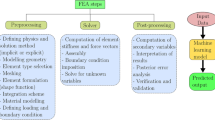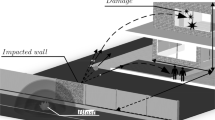Abstract
Region partition (RP) is the key technique to the finite element parallel computing (FEPC), and its performance has a decisive influence on the entire process of analysis and computation. The performance evaluation index of RP method for the three-dimensional finite element model (FEM) has been given. By taking the electric field of aluminum reduction cell (ARC) as the research object, the performance of two classical RP methods, which are Al-NASRA and NGUYEN partition (ANP) algorithm and the multi-level partition (MLP) method, has been analyzed and compared. The comparison results indicate a sound performance of ANP algorithm, but to large-scale models, the computing time of ANP algorithm increases notably. This is because the ANP algorithm determines only one node based on the minimum weight and just adds the elements connected to the node into the sub-region during each iteration. To obtain the satisfied speed and the precision, an improved dynamic self-adaptive ANP (DSA-ANP) algorithm has been proposed. With consideration of model scale, complexity and sub-RP stage, the improved algorithm adaptively determines the number of nodes and selects those nodes with small enough weight, and then dynamically adds these connected elements. The proposed algorithm has been applied to the finite element analysis (FEA) of the electric field simulation of ARC. Compared with the traditional ANP algorithm, the computational efficiency of the proposed algorithm has been shortened approximately from 260 s to 13 s. This proves the superiority of the improved algorithm on computing time performance.
Similar content being viewed by others

References
ZHOU Shu-quan, DENG Shao-zhong. Some recent advances in the parallel computation of finite element structural analysis [J]. Journal of Nanjing University of Aeronautics & Astronautics, 1995, 27(1): 27-32. (in Chinese)
GICQUEL L Y M, GOURDAIN N, BOUSSUGE J F, DENIAU H, STAFFELBACH G, WOLF P, POINSOT T. High performance parallel computing of flows in complex geometries [J]. Comptes Rendus M¨¦canique, 2011, 339(2): 104-124.
ZHANG You-liang, FENG Xia-ting. Parallel computation of finite element model with millions of DOF in geotechnical engineering [J]. Rock and Soil Mechanics, 2007, 28(4): 684-688. (in Chinese)
WANG Jian, CHEN Bing-zhen, HE Xiao-rong. Parallel computing applied in chemical process simulation and optimization: A review [J]. Journal of Chemical Industry and Engineering (China), 2002, 53(5): 441-446. (in Chinese)
QI Wen-guo, JIN Xian-long, ZHANG Xiao-yun, LI Yuan-yin, LI Gen-guo. Finite element simulation and performance study of vehicle crash based on parallel computing [J]. Journal of System Simulation, 2004, 16(11): 2428-2431. (in Chinese)
KALRO V, TEZDUYAR T E. A parallel 3D computational method for fluid-structure interactions in parachute systems [J]. Computer Methods in Applied Mechanics and Engineering, 2000, 190(3/4): 321-332.
NAKANO T, KAWASE Y, YAMAGUCHI T, NAKAMURA M, NISHIKAWA N, UEHARA H. Parallel computing of magnetic field for rotating machines on the earth simulator [J]. IEEE Transactions on Magnetics, 2010, 46(8): 3273-3276.
WANG Hu, LI Guang-yao, ZHONG Zhi-hua. Optimization on automatic mesh partition method in parallel finite element computation [J]. Journal of Computer-aided Design & Computer Graphics, 2005, 17(8): 1766-1772. (in Chinese)
KLAWONN A, RHEINBACH O. Highly scalable parallel domain decomposition methods with an application to biomechanics [J]. ZAMM-Journal of Applied Mathematics and Mechanics, 2010, 90(1): 5-32.
FARHAT C. A simple and efficient automatic FEM domain decomposer [J]. Computers & Structures, 1988, 28(5): 579-602.
GUÉNOCHE A. Comparing recent methods in graph partitioning [J]. Electronic Notes in Discrete Mathematics, 2005, 22: 83-89
KARYPIS G, KUMAR V. A fast and high quality multilevel scheme for partitioning irregular graphs [J]. SIAM Journal on Scientific Computing, 1998, 20(1): 359-392.
SUI X, NGUYEN D, BURTSCHER M, PINGALI K. Parallel graph partitioning on multicore architectures [M]// Languages and Compilers for Parallel Computing. Springer Berlin Heidelberg, 2011: 246-260.
RAMA M OHAN R AO A. Parallel mesh-partitioning algorithms for generating shape optimized partitions using evolutionary computing [J]. Advances in Engineering Software, 2009, 40(2): 141-157.
AL-NASRA M, NGUYEN D T. An algorithm for domain decomposition in finite element analysis [J]. Computers & Structures, 1991, 39(3): 277-289.
KARYPIS G. Multi-constraint mesh partitioning for contact/impact computations [C]// Proceedings of the 2003 ACM/IEEE Conference on Supercomputing. Phoenix, Arizona, USA: ACM, 2003: 56.
PELLEGRINI F. Current challenges in parallel graph partitioning [J]. Comptes Rendus M¨¦canique, 2011, 339(2): 90-95.
LASALLE D, KARYPIS G. Multi-threaded graph partitioning [C]// Parallel & Distributed Processing (IPDPS), 2013 IEEE 27th International Symposium on. Boston: IEEE, 2013: 225-236.
ZHAO Xian-yong, CHEN Xiao-fang, GUI Wei-hua. EBE-based parallel finite element analysis of electric field in aluminum reduction cell [C]// Intelligent Control and Automation (WCICA), 2012 10th World Congress on. Beijing: IEEE, 2012: 2939-2943.
Author information
Authors and Affiliations
Corresponding author
Additional information
Foundation item: Project(61273187) supported by the National Natural Science Foundation of China; Project(61321003) supported by the Foundation for Innovative Research Groups of the National Natural Science Foundation of China
Rights and permissions
About this article
Cite this article
Wang, Yl., Chen, Dd., Chen, Xf. et al. Dynamic self-adaptive ANP algorithm and its application to electric field simulation of aluminum reduction cell. J. Cent. South Univ. 22, 4731–4739 (2015). https://doi.org/10.1007/s11771-015-3025-5
Received:
Accepted:
Published:
Issue Date:
DOI: https://doi.org/10.1007/s11771-015-3025-5



